Barry Miles's Blog
September 19, 2025
2025 August
Camila is editing an anthology of Allen Ginsberg poems that relate to his 1948 auditory vision of William Blake’s voice coming to him across the vault of time, reading poems from Songs of Innocence and of Experience. I am writing the foreword. To do this we first had to agree on the meaning of each selected poem. I thought I was familiar with them all as I once spent a year editing Allen’s tape collection and selecting the best live recording of each of his published poems, but even so I was occasionally puzzled as to what he actually meant. (Allen himself sometimes didn’t know, sometimes placing two words together in the same way as Cezanne placed two colours together to get what Allen called ‘eyeball kicks’. He had also written quite a number of poems since I did that work back in 1971. By reading them aloud and discussing each one the meanings became clear. It was insightful work and, in fact, a delight to revisit poems that I mostly hadn’t read in decades. As you can see it was exhausting work.

Although we worked every day, there was still time for meals, for a drop of wine, and visits to friends. Martha has a swimming pond, surrounded by plants and flowers with a superb view of the mountains.

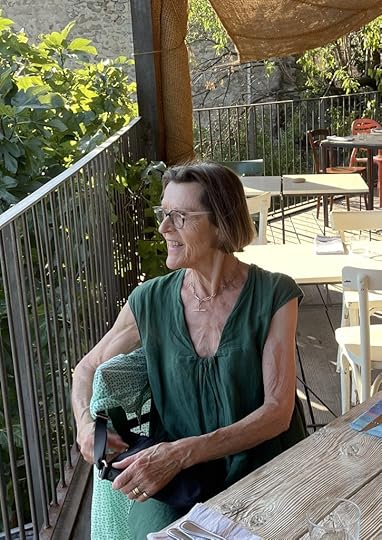
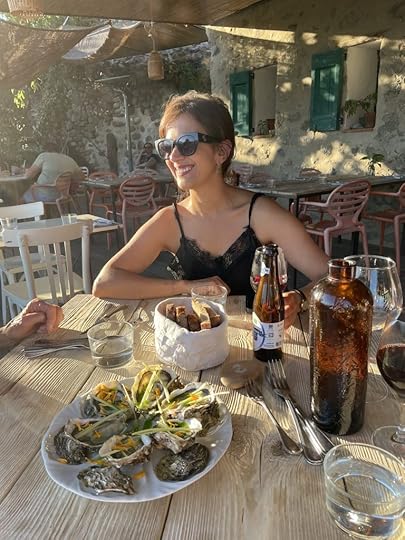
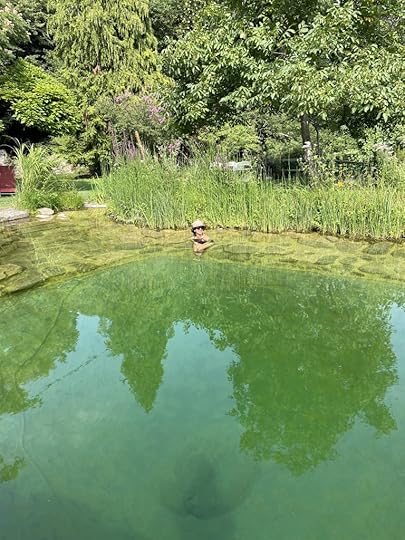
We went with Martha to a concert of Bach Cantatas played by the Ensemble Correspondences at the tenth century abbey of St. Michel de Cuxa, part of the Pablo Casals Festival. The building was erected in 950 in the Mozarabic style and has superb acoustics. I was not that happy with the lighting which was sometimes distracting and would have preferred to see the 1000-year-old horseshoe arches in their natural colours, but it was a great concert.
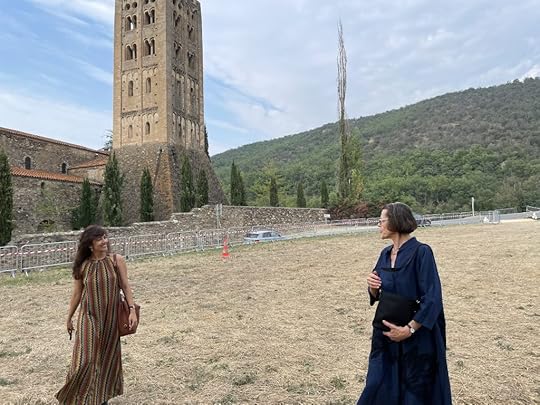
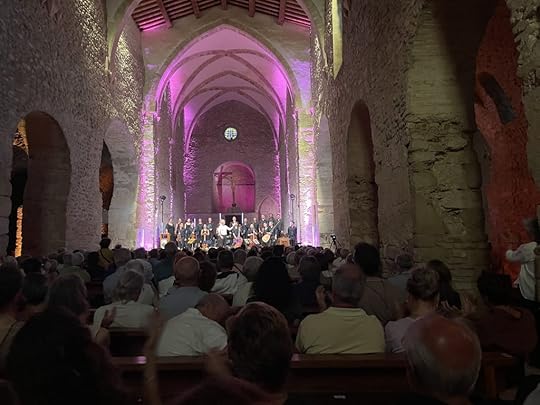
I forgot to mention the Anselm Kiefer-Van Gogh show in last month’s post. Jill and I went to the show which was at the Royal Academy. As usual I found these artist pairings to be a little forced. It’s true that Kiefer liked Van Gogh but he wasn’t that much influenced by him. There were some nice Van Goghs though.


Back to France and my next visitors were Ken Weaver and Maxine. I hadn’t seen them since I visited their place last year with a film crew who were making a documentary about Ken’s fellow-Fug Tuli Kupferberg. Here’s Roslyn with Maxine and Ken in Prades. They overlapped with Richard and Suzy. Suzy had just completed a six month residency at the Citie des Arts in Montmartre and I really regret not having the time to visit them there. They brought with them some rather interesting anarchic local wines from the other wise of the Col.
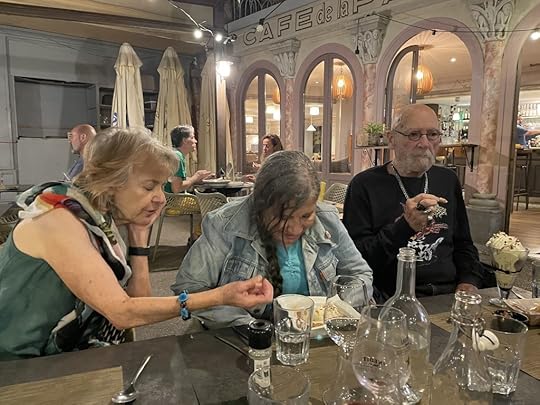
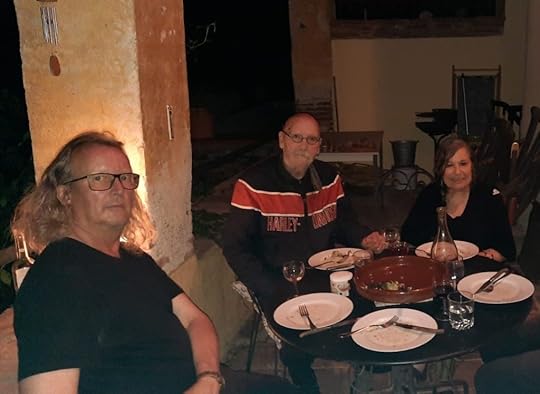


I saw quite a lot of Roslyn and Gordon which was good because they rarely come down to London. Unfortunately, we didn’t overlap by many days as they had to return to Britain because of Brexit rules (a pox on all who voted Brexit!). There was time for one more concert: the Cobla Sol de Banyuls did a free concert at the local church. It is some of the strangest music you will ever hear in Europe; despite the bass being the only stringed instrument, it sounds like the string section of an orchestra. A cobla consists of 10 wind instruments and a double bass, with one person playing both a flute and a hand drum attached to his wrist. Women have only been permitted to play in a cobla since the 1980s and to my disgust, at the end of the concert, only the men were called to stand and take a bow by name. They played modern works, but all had the distinctive triple beat of the Sardana at their root (actually a 6/8 rhythm). It has a slightly sinister feel, an echo of the distant past. The earliest reference to the Sardana is from 1552. Here’s more what-we-did-on-our-holidays pix of the cobla and of Gordon and Roslyn with Catherine and Billy and their daughter Niamh.



My final visitor of the summer was Marsha Rowe, veteran of Australian Oz, English Oz, co-founder and editor of Spare Rib and co-founder of Virago Books. We have been fellow travellers for decades, hoping to subvert people! She last appeared here throwing eggs with Sara Lucas. Meanwhile, bamboo threatens to overtake the garden and life goes on, at least for a bit longer.



September 1, 2025
August 23, 2025
I usually try to get to the Soho Fete each year. Held in the churchyard of the wartime bombed St. Anne’s, on Wardour Street, it remains a truly local affair, with the bar run by the French pub and locals manning the stalls. There is a Soho waiters’ race that starts and ends outside the French, when waiters carrying a tray with a bottle of champagne, a glass and an ashtray, run up Dean Street, round Soho Square, back down Greek Street and across Romilly Street to the finish line; this year won by the Ham Yard Hotel. The London Fire Brigade won the tug-of-war against the local police and the London pearly kings and queens were out in their finery All the usual attractions were there including the Human Fruit Machine and the snail race, a Rocky Horror show singalong, the drag queen finale and a few choruses of ‘My Old Man’s a Dustman’ and ‘Cock Linnet’. How London can you get? Here’s the Fire Brigade getting their award and some of the alternate London royalty showing community support.
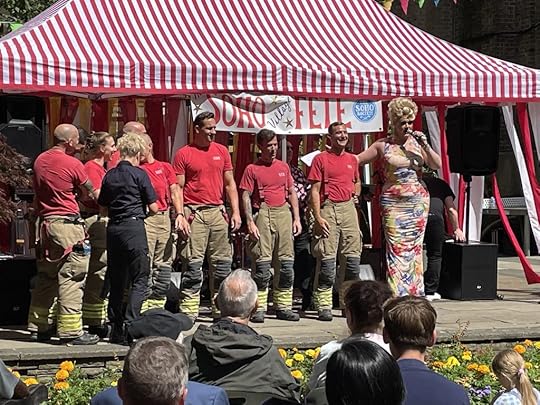



My son Theo was there with Mina. I went with Lucy but soon ran into Hannah. I love being with them both and when the fete ended we went on to The White Horse on Newburgh Street, next to Carnaby Street, where The Fallen Heroes, friends of Lucy’s, were playing. The three of us finally got home where I had fortunately prepped a meal that I somehow managed to cook. It was a real Soho day in brilliant sunshine, though it took me a day to get over it.



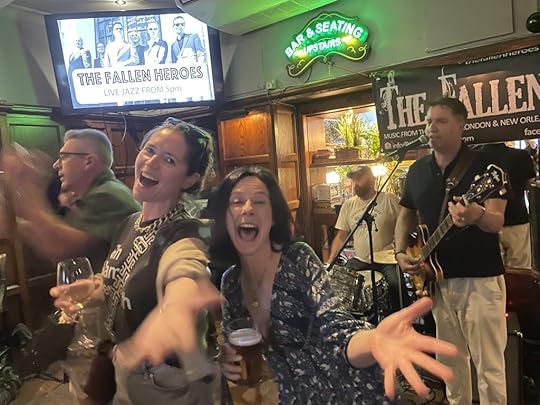
The US has left UNESCO yet again, following their withdrawal from the Paris Climate Accords and WHO. It’s really only their money that will be missed as the US has very little in the way of culture, given the size of its population; the Paris Climate Accords are inimical to the oil business so American compliance with any attempts to cut back on oil production were always likely to fail, and of course, with regard to WHO, the US is the only developed country in the world to not have a national health system. In other words, reactionary through and through, and destined to get worse as their position in the world becomes less and less significant. In fact, to use one of Trump’s favourite phrases, a real ‘shithole country’.
On a lighter note. Camila and I went to see the David Hockney show at the Fondation Louis Vuitton in Paris. All the great pictures were there: A Bigger Splash; Peter Schlesinger looking petulantly into a swimming pool and waiting expectantly on a bed; ‘Mr & Mrs Clark and Percy’,; the giant landscapes and the wonderful Royal College work from the early sixties which I have always liked. I sent Raymond Foye a pic of his portrait with Henry Geldzahler to show that we thought of him while viewing the picture. Sadly the Wayne Sleep-George Lawson double portrait wasn’t there, it would have been a nice tribute to George who died not that long ago.



We were there largely to see Hockney’s new William Blake picture as Camila is a Blake scholar, on the board of the William Blake Society and the Blake Cottage Trust, and we were en route to the Pyrenees to spend a week working together on an anthology of Allen Ginsberg’s poems about the auditory vision of William Blake back in 1948 that so very much influenced his life and poetry.


The next day we went to the Museum d’Orsay. I sought out the Suzanne Valadon pictures, as I have been studying her work recently. The collection of Impressionists there is astonishing, I would love to live next door and see the pictures all the time. There was a Courbet there that caught Camila’s eye and a Renoir that matched her hat. I naturally did a bit of mansplaining having been several times to the Monet in London show recently at the Courtauld.



Paris would not be Paris without a few nice drinks. We were at Hotel La Louisiane, so the Palette was just up the street where William Burroughs used to score for heroin and boys – how things have changed! The pina colada pic was taken at the Rhumerie, the old rock ‘n’ roll haunt from when I was a rock critic in the seventies. All the visiting bands used to hang out there.
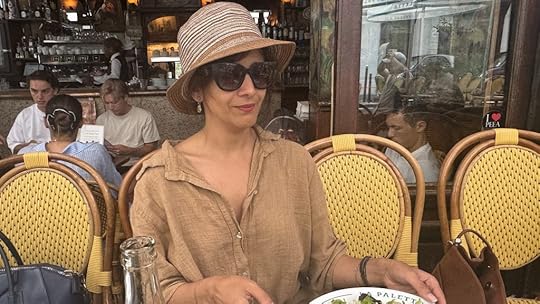

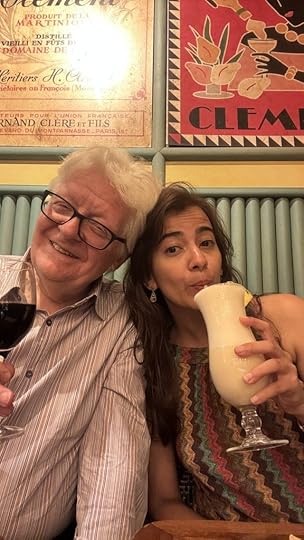
Next day we were on our way south.

July 22, 2025
June – July 2025
Hannah Watson asked me for an essay on the role that the Liberty store played in cultural history to be included in a box set of booklets and essays published to celebrate the store’s 150th anniversary. Oscar Wilde praised it, it promoted the arts and crafts movement, was loved by the bright young people, dressed the Chelsea set, provided furnishing fabric for Granny Takes a Trip’s psychedelic jackets and David Bowie’s many personalities, before finally showing up at Taboo in Leigh Bowery’s fantastic costumes. There was a suitable launch in the exhibition of their historic fabrics in the store’s fourth floor exhibition. I wore a Liberty foulard.


I have been working a lot with Ed Maggs from the venerable antiquarian bookstore Maggs. He kindly turns to me when the subject of an archive falls within my specialisms: Beat Generation, British Counterculture and so on. Here is a particularly pleasant evening I spent with Ed and Fran at my local Italian.

On June 22, we had a visit from my God-daughter Sara Minard, born in London of American parents and living in New York City. I hadn’t seen her in a while and forgot that she was a vegetarian. Here is her reaction to a tray full of roast quail. She works for the mayor’s office so she is a diplomat. She ate one.

There was an on-stage interview with Nicola Bowery Rainbird, Leigh Bowery’s wife, to go with the huge Leigh Bowery show on at Tate Modern. I went with Hannah who curated the previous Bowery show, held at the Fitzrovia Chapel (I wrote one of the catalogue essays). Here’s Hannah with Nicola, her son Angus, and gallerist Riccardo Pillon. The party spread to the grass outside the Tate beside the Thames. Hannah is here with Jessica Baxter, who curated the Tate show.



The global-warming fuelled summer sun brought out the flowers. My old friend Fran Bentley showed me her garden.

It had been ages since I saw my friend Yang Lee. He came over with Lisa and here he enjoys a smoke with George Orwell. Lisa is a model from Novosibirsk, Siberia, and we discussed the role of Siberian troops in the Battle for Moscow in WWII. (Always high-level intellectual conversation around here you understand.) We dined at the Wolseley.
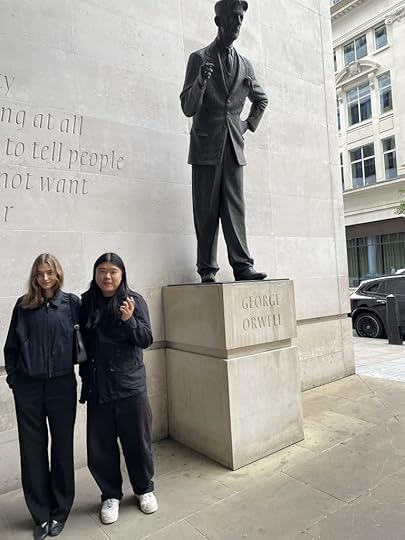
In Paris to discuss a show of Brion Gysin’s work at the Musée d’art moderne de Paris, I stayed at the Hotel La Louisiane on the rue de Seine. It’s always an exercise in false nostalgia as I never met J-P Sartre, Simone de Beauvoir, Albert Cossery, Boris Vian, Albert Camus or Fujita who lived there. Or Charlie Parker, Bud Powell or any of the jazz greats who stayed there (it was where Miles Davis and Juliette Greco had their legendary affair in 1948). More recent guests included Jim Morrison, Keith Haring, Lucien Freud and Juliette Binoche. It’s still cheap – by Paris standards – and though that part of the Left Bank is now insanely expensive and gentrified, it reminds me of how it used to be when I first stayed in the area – at the Hotel de Seine a few doors up the street – back in 1966. My friend Luzius was also staying there, in town from Basel, for the same meetings, being the owner of a substantial collection of Gysin material. His wife Sairung was with him, here at the Palette. On our off-day, Luzius and I visited the Balzac Museum, which neither of us had been to. This is the desk at which he wrote La Comédie humaine. It’s a beautiful small museum – free, unusual for Paris – with a delightful garden and café. It is hard to imagine that when the house was built it was in open countryside.


Luzius and I were in Paris to meet with Hélène Leroywho is the Conservatrice en chef, Responsable des collections at the Musée d’art modern de Paris, and is organising a Brion Gysin exhibition for 2026 together with Olivier Weil. We have had previous meetings both here and in London and we are all in agreement as to how the show should look. Here we have Olivier, Hélène and her daughter Julie, at one of my favourite Parisian cafes, Chez René on blvd St Germain. (The snails are very good – huge, and they also do frogs’ legs. It’s a proper place.)

I ended my visit with a couple of nights with my old friends Catherine and Steve. We went to the Niki de Saint Phalle and Jean Tinguely show at the Grand Palais. It is a huge show. I should have done my usual thing of running through the show first then returning to the start and pacing myself, as there were loads of videos that, for once, I really wanted to stop and see. But I didn’t and we were there almost two hours. I hadn’t realised how much of their work was genuine collaboration rather than mutual support. I had a picture of them, torn from a magazine pinned to my wall when I was art school back in the early sixties, and have always liked their work enormously. When we started International Times, one of the first art illustrations we used was of Nana, the huge sprawling female figure that you entered between the legs, that only existed for six months in 1966 at Stockholm’s Moderna Museet before it was destroyed. Fortunately, a few fragments remain: the head was at the Grand Palace and a fragment of torso. More importantly there was a lot of very interesting documentation about the figure and the original show.

There were also some major examples of her ‘tir’ series, where she made large assemblage ‘paintings’ which incorporated bags of paint which she, and invited friends, then shot at, causing the paint to spray and drip all over the work. William Burroughs credited her with being an influence on his ‘shotgun’ paintings. The pieces, before-shooting, reminded me of Robert Rauschenberg’s work, and indeed, he was one of her friends and did some of the shooting.
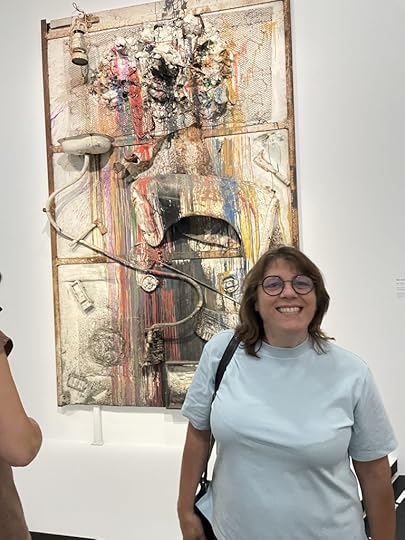
And of course there were loads of Tinguely’s amazing machines, including several painting machines, shown here, as well as films of the ones that auto-destructed like the one in New York. In the film a small section, like a small trolly, can be seen escaping as firemen tackle the implosion and it is displayed in the show, next to the film of the event.
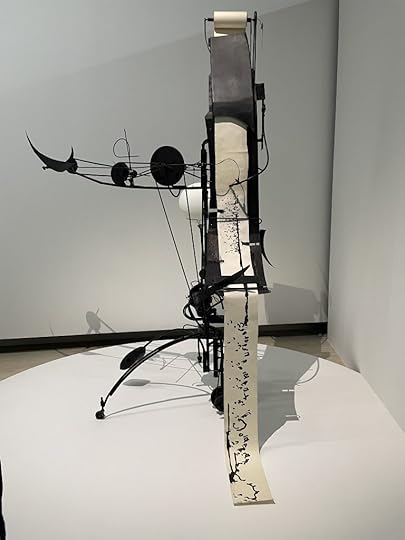
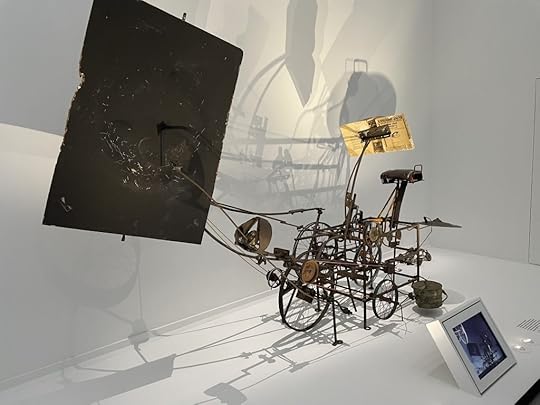

Catherine and Steve collected me and my baggage from the hotel and it was fun to hang out at my old haunts with them. Back in the sixties and seventies the area was still cheap and filled with inexpensive hotels that you could just show up at and get a room. Then they started installing lifts, putting up the price, then they were bought out. Only a few remain today like the Hotel du Seine or La Louisiane. The Palette is still there, and the mirrors are becoming more and more corroded. Bill Burroughs liked it here.

Catherine and I visited the Musée de Montmartre, housed in a 300-year-old complex of artists’ studios and housing. Renoir lived here, (his garden has been recreated), as did Raoul Dufy, Suzanne Valadon, her husband André Utter and her son the painter Maurice Utrillo. Valadon’s studio is preserved intact with no vitrines or glass protection and you can just wander about in it. It’s like time travel. A wonderful experience.



The museum also contains items from Le Chat Noir. Here is the original zinc, complete with ancient bottles, Catherine, and me.


A visit to Paris would not be complete without a dinner with Brunhild Meyer-Ferrari and her companion Junor. Her latest recording, ‘Errant Ear-2024’ has just been released. She worked with her husband, composer Luc Ferrari for 40 years and after his death in 2005 continued to release her own recordings. Catherine cooked a superb dinner for us all, then apparently tried to raise the table. Pix by Junor.



Remember that from the river to the sea it’s all Palestine. Israeli genocide continues.

June 22, 2025
May-June 2025
The spring weather brought everyone out and we had a very busy start to May with dinners for Lucy and Valerie. Luzius Martin and Udo Breger arrived in London on the 5th and we had our usual dinners: one in a restaurant and one here the following day, always accompanied by Terry Wilson, who lives here. On the 8th we all had lunch with Tom Neurath at the Palestinian restaurant beneath his office on Golborne Road in Notting Hill. Tom was not looking at all well. He had lost considerable weight and had grey skin. Nonetheless, he spoke enthusiastically about his collection of Samuel Beckett first editions and asked me to have Ed Maggs send him the list of Beckett items that I knew that they were about to send to auction. His numerous cancer treatments had all failed and though they were trying a few experimental procedures he knew that he was dying. Consequently, he taken up smoking pot and cigarettes again and, certainly a few months before, was drinking a little schnapps again. We had an almost tearful hug when we all departed. We knew it was unlikely that we would see each other again.
I kept up on the art world: the next day Marsha Rowe and I attended the opening of the refurbished Sainsbury wing of the National Gallery. Architecturally it seems to be a great improvement, but they still light the pictures from high above, throwing big black shadows from their frames across the tops of many of them, distorting the size ratio, obscuring detail, and very much damaging the viewers’ enjoyment. Why they can’t lower the lighting gantries by 10 meters or so is beyond me. Any rock ‘n’ roll lighting roadie could do it for them and it wouldn’t even cost very much to do. [I can recommend some.] As it is, the hang is a disgrace. In some cases, the shadow obscures the top half of a figure’s head or puts a strong wavy line across the top of the picture, distorting the composition. Typical of Britain, I’m afraid. Here’s Raphael’s Garvagh Madonna [1510]; Pontormo’s Joseph’s Brothers Beg For Help [1515] and his Joseph Sold to Potifer with their thick shadows.



My other art day was to have a pleasant lunch with Andrew Wilson and art dealer Anthony Reynolds at the Academy Club which is always a relaxing yet invigorating place at lunchtimes. Of course in the evenings the members can sometimes become boisterous as you can see.
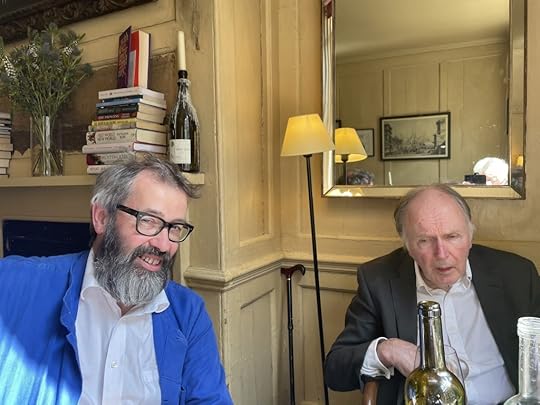
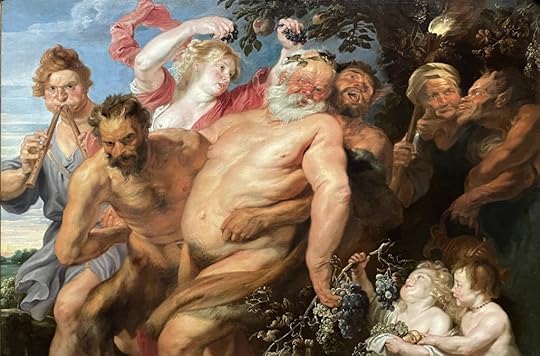
Theo, Mina and I flew to France on the 14th where Rosemary’s sister Jackie had assembled eight of her family members for a reunion. They all came to dinner of course, but were staying about an hour’s drive away so I didn’t see much of them. Theo joined them for one night and they all had a good time on the coast. Theo and Mina in France.


Back in town I resumed the usual round of dinners and visits to exhibitions as befits an elderly man in London: dinner with Lucy, show and a dinner with Jill – the Hiroshige show at the British Museum. I enjoyed it but was disturbed by the fact that all the women looked the same: same face, same blank expression, even if he was depicting a crowd of a dozen or more, they were all clones. It revealed a lot about the situation of women in eighteenth and nineteenth century Japan, they were virtually inviable. But his colour and his un-western perspective is wonderful. They are prints, and his publishers have sometimes substituted different colour backgrounds which completely change the reading of the composition, it’s all fascinating.)
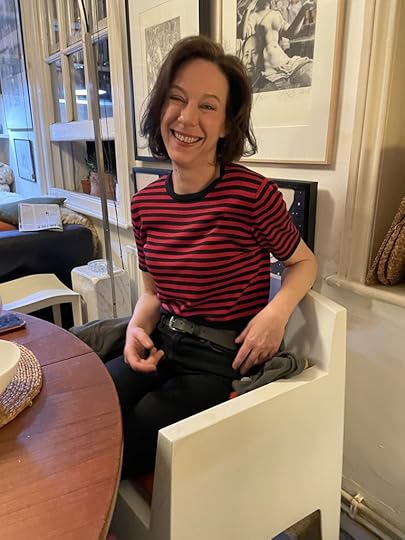

Tom Neurath died on Saturday 14th June. I had known him since 1965; 60 years. We were introduced by Ian Sommerville who first became his friend in 1959 at the Beat Hotel in Paris where they both lived. Tom had always been a supporter of Ian and his work and collected his infinity-grid pictures. He was also a friend of Hoppy, who I shared a flat with in the mid-sixties, so I quickly got to known him. We were not close, but over the years we did quite a few things together. We once took the Thames & Hudson Rolls Royce down to Deal, on the coast, to meet Harold Chapman whose book of photographs, The Beat Hotel, [1984] was out of print. Tom was considering re-issuing it. The problem was that the reproductions in the original edition were not good enough to use for a reprint, so we were going down to hopefully collect the original prints or inspect his negatives to find possible substitutes or additions for an enlarged edition. Of course Harold hadn’t prepared anything. He finally found a box with a few curled-up prints but couldn’t find any contact sheets or anything that would have been of use. He pontificated about this and that. Claire produced a bottle of whiskey and the afternoon drifted by, but the visit was a waste of time. Either Harold didn’t want to really re-issue the book, or his dementia had already set in, and we hadn’t realised.
Another time, more amusing, was when Peter Weibel, the director of ZKM in Karlsruhe, invited Tom and I to give a talk on ‘Swinging London’. A less likely subject for Tom to speak on would have been hard to find as he had not been a part of that scene at all. But it sounded like a fun project, so we flew out and sat in conversation, in English, before a packed auditorium. I don’t recall anyone leaving so I think they were entertained. I will miss him.

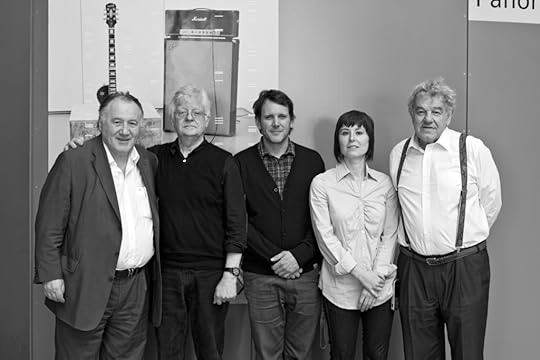

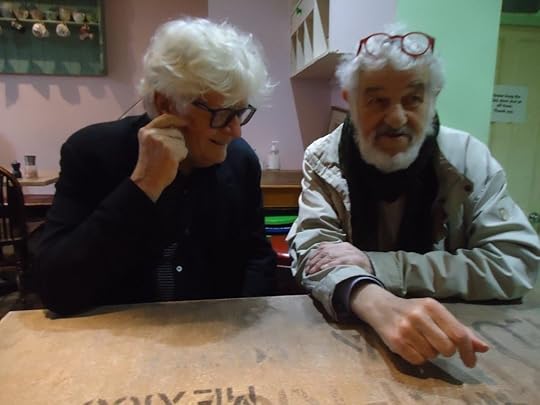


May 3, 2025
April 2025
We visited Michaelangelo’s house, the Casa Buonarroti where he lived between 1516 and 1525. A nice small museum with very few other visitors even though it contains several interesting works. I love house museums and though it doesn’t have any original furniture or anything like that, it is still wonderful to inhabit the physical space that their owners once occupied. The two low reliefs in the museum are in a small, pleasant room with somewhere you can sit and have a proper look at them. They are the Madonna of the Stairs [c1491] and the Battle of the Centaurs [1492] both made when he was still a teenager but both fully mature works.
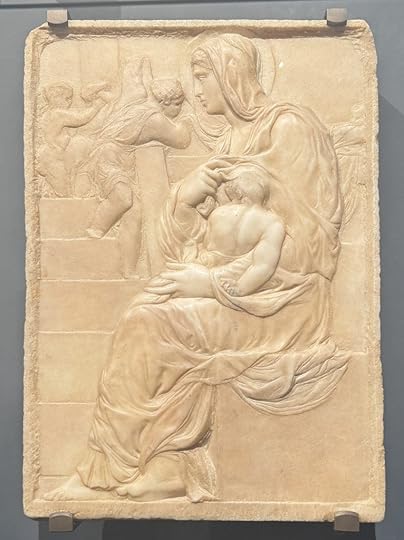

With no-one around, these beautiful Renaissance rooms were a perfect place for a couple more Ceiling Portraits:
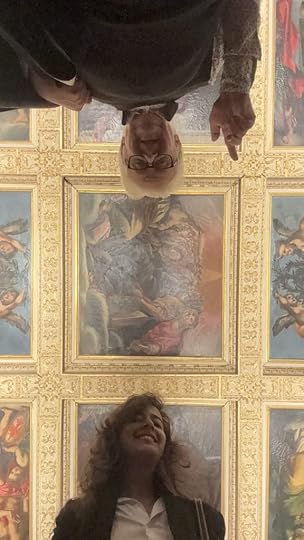

Camila is a perfect travelling companion. She listens attentively while I dredge up factoids, half-remembered from history of art lectures at my art college of sixty years ago.

I found the visit to the Basilica of Santa Croce a very moving experience. The mythical figures of history take on a new reality when you look at their tombs. Here is Galileo, and directly across the nave from him is Michelangelo in a tomb designed by his great friend Vasari. And to the left of him is Dante! (Well, a cenotaph, actually). And so it goes, all these local boys. Here’s Machiavelli and in the Sacristy is Cimabue’s crucifix, (1288) still damaged from the terrible 1966 floods. (I first saw it in 1968 when evidence of flood damage was everywhere.) And finally there is a woman, at the end of the First Cloister is a monument to Florence Nightingale from 1913. Here, in order, Galileo, Michelangelo and Machiavelli.



Even though it was only April, there were already crowds of tourists. In the Uffizi there was a queue for the Tribune, so we joined it, not knowing what it was. It is, of course, the octagonal gallery built by Francesco 1 de’ Medici in 1584, and famously painted by Zoffany. I should have remembered. At the head of the queue we found that you can only look in the door, but it is a wonderful room with a domed ceiling and Grego-Roman statuary arranged around it. In the centre stands the Medici Venus, dating to the end of the second century BC, a marble copy of a bronze Greek original. William Blake’s father bought him a cast of this when he was studying at Henry Pars’ drawing school on the Strand and there is also a cast in the Royal Academy School. She is justly famous, a reference point in the history of Western art. I was pleased to see the original.

Camila enjoyed the Botticelli room. It is filled with his works but the tourists cluster around the two most famous: The Birth of Venus and Primavera. Fortunately the crowds thinned out enough to get a good view of everything there. It’s only when you see the two most famous pictures in reality and can appreciate their size and the luminosity of the painted surface that you can fully understand them. The endless repetition of the images on tea-towels, t-shirts and coffee mugs have reduced their impact to mere branding, but up close you can see why the Pre-Raphaelites loved him so much and copied him so slavishly. We, of course, also took photographs. One of my favourites was another Venus, busy shocking the local prudes, in Calumny of Apelles. We liked the Uffizi. Here we are in the roof terrace café.




The Museo del Bargello has four Michelangelos, more than anywhere else in Firenze, but it was almost empty. They are a bust of Brutus, a life-size Apollo, the Tondo Pitti, and my favourite, the early, 1496, Bacchus, huge, tipsy if not completely pissed and looking as if he’s about to fall over.

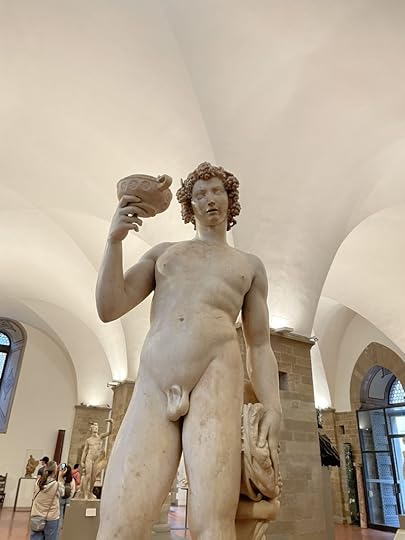

I was expecting to find crowds at Michelangelo’s tombs in the Medici Chapels in San Lorenzo but there were only one or two people there. It was a good photo-op (sorry). The figures are magnificent, Michelangelo twists them uncomfortably to make the stone live. The main chapel is totally over the top as we used to say. The Medici balls are everywhere, and you could spend hours just looking at the variety of coloured marbles. Here we are with Lorenzo, followed by Giuliano’s tomb that faces it across the chapel.

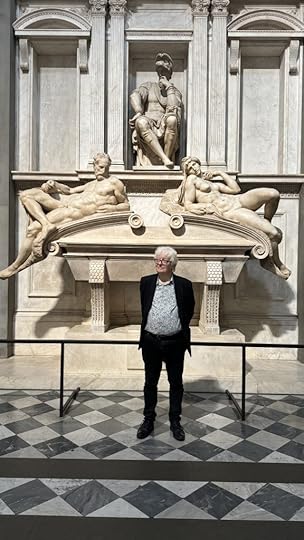
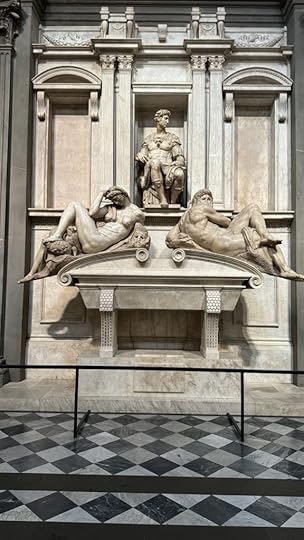

It was not all museums, though as it rained so much, they were a welcome shelter. At the back of the Mercato Nuovo, the 16th century covered market (not worth seeing) there is a bronze boar, Porcellino, whose snout fingers have polished gold. Touching it guarantees your return to Firenze, so Camila will be back. People also put coins in its mouth, which is obviously what the chap sitting next to it is waiting for.
At the Palazzo Vecchio Camila acts her Cabral moment and discovers Brazil. Pedro Álvares Cabral landed in Bahia, her home estado, on 22 April 1500, claiming it as a Portuguese colony. This was a disaster for the Tupinambá and the Tupiniquin whose land it was.
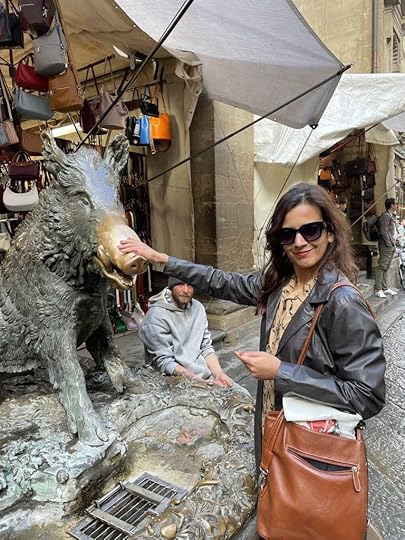

Despite our pointless Florance City passes, we could only get tickets for the Accademia four days hence. They were for 3:00pm. We finally got in at about 4:10. The Accademia has nowhere for people to wait so the street outside was thronged with people and umbrellas. The gallery only allows a certain number of people to enter but, because of the rain, no-one was leaving. (The worst example of this poor planning is the Fondation Vuitton in Paris designed by Frank Gehry and costing $790 million. There is nowhere to wait so in the summer the long lines form outside in the sweltering heat and in the winter, they line up in the cold with umbrellas. I used to admire his architecture, but this building is a piece of egotistical shit. He should give the French State back their money. Over $600 million came from the French taxpayer. Harrumph!) The Accademia was established in 1784 when presumably the numbers of visitors were in the dozens not thousands (1.46 million visitors in 2016).
It is the home of Michelangelo’s David. That’s what they are all there for. It is also home to his four unfinished Prisoners, originally intended for the tomb of Pope Julius II and a statue of Saint Mathhew. But it is David they have all come to see. The slab of marble had already been worked on by two previous sculptors before Michelangelo got it and was also quite shallow, meaning that he had to create a frontal figure without much projection into space. He worked from the front rather than the usual all-round shaping and by getting quite close in towards the final shape he automatically shaped the sides while the back remained very roughly hewn until the end. This method gave him room to improvise rather than working from a pre-ordained idea of the piece. The head is large to allow for perspective when seen from below. The hands are overlarge and expressive. It is quite rightfully regarded as his greatest work. In a nice reversal of the male gaze, we went round the back to have a look at his bottom. There were several young women there, demonstrating the female gaze, and Camila was one of them. He has a nice ass. The prisoners are tremendous: struggling to free themselves from the blocks of marble that encase them. They are wonderful as they are, unfinished.
The museum has a few other works, paintings by Botticelli, Giotto and Lippi and several rooms devoted to a collection of musical instruments including a violin cello and a tenor viola made by Stradivari.



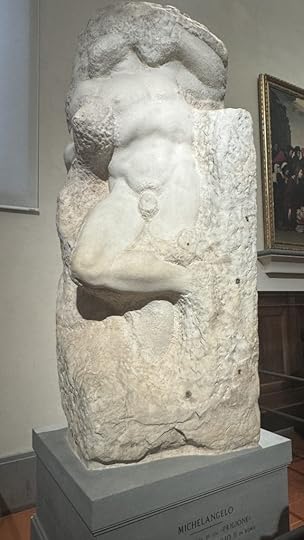

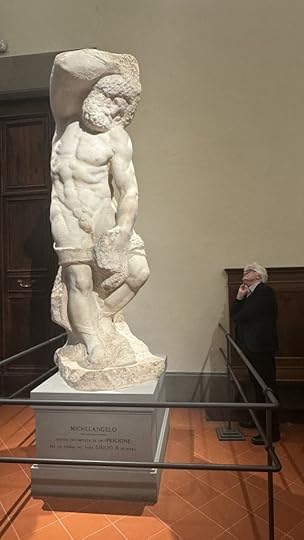


And so to Siena, but first a quick look at Percy Shelley’s gaff which is just across from the station.


To get from the station to the town, you have to go up 10 elevators. It takes ages but it certainly saves walking to the top of the hill. At the top was one of my favourite street signs which presumably means; ‘If you piss here we will cut your balls off!’ In Siena all roads lead to the Piazza del Campo where each year they hold the Palio. Siena seemed a nice town, perhaps a little quiet. Everyone seemed to be a tourist, as if it was a ghost-town with no-one actually living there. Finding lunch was difficult but we managed.
Back to Firenze and then London. No Stendhal Syndrome, which some doctors argue comes from tilting your head back to look upwards so much that it restricts the blood supply to the brain and makes you feel faint. Firenze cannot compare to Venice, but I’d be delighted to visit again, when it’s sunny.

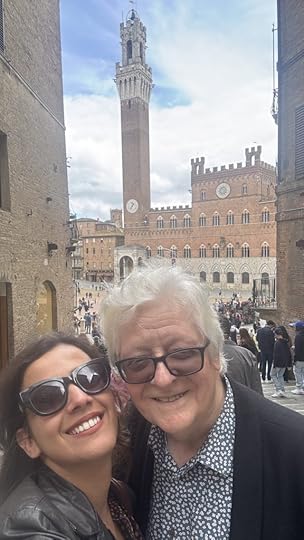
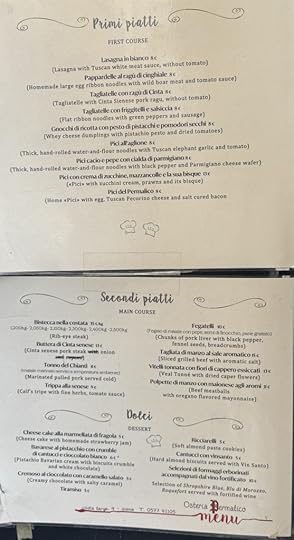


April 2025
With the USA becoming more and more fascistic, one way that universities such as Harvard can retain their independence would be to move most of their endowment fund and research to Britain – or France, Spain, wherever – thus protecting them from the criminal Trump and his imbecilic followers. John Harvard went to Emmanuel College, Cambridge, so that would be an obvious place for Harvard to build a facility. The main university could stay in Cambridge, Mass., but all other activity would enjoy intellectual freedom here in Britain.
I have been on my travels again. Camila and I went to Firenze on April 15th, our third visit to Italy. Previously we had been to Naples, to see Pompei and Herculaneum, and Venice. Unfortunately, it rained every day we were in Firenze except for the day we went to Siena, which was perhaps fortunate as Siena involved quite a bit of walking whereas everything in Firenze in close together. Fortunately the food in Firenze is excellent, as shown here.


Though there were some steady downpours, the rain was mostly confined to showers and we were able to see most of the things we wanted. The copy of Michelangelo’s David on Piazza della Signoria, for instance, and the famous bridge. In other words, all the tourist sites. This is a ‘what we did on our holidays’ blog.
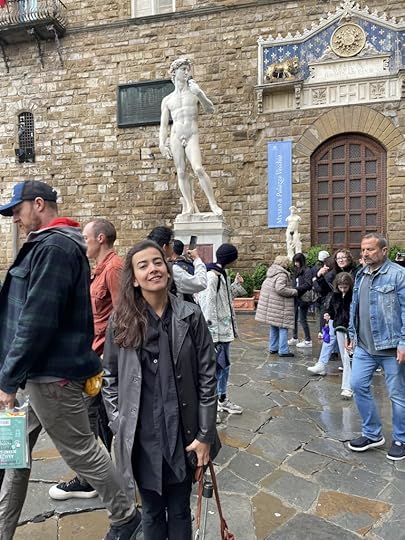


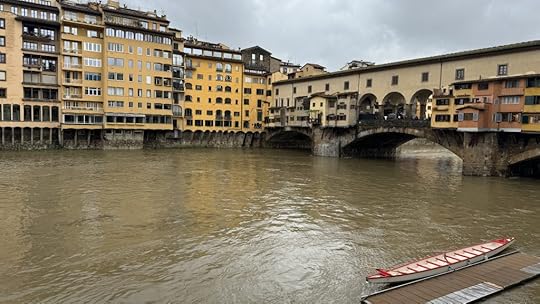
I was pleased to see that the street art in Firenze was quite sophisticated. I collect street sign art and was able to capture some very good examples while there, as you can see:


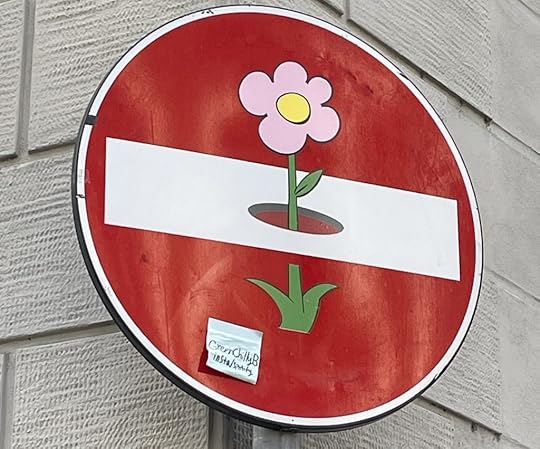
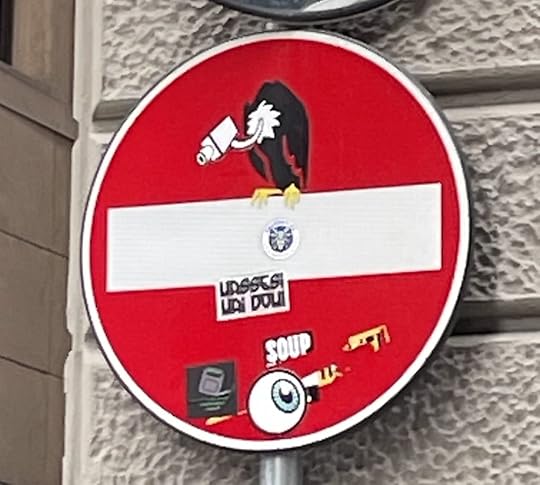

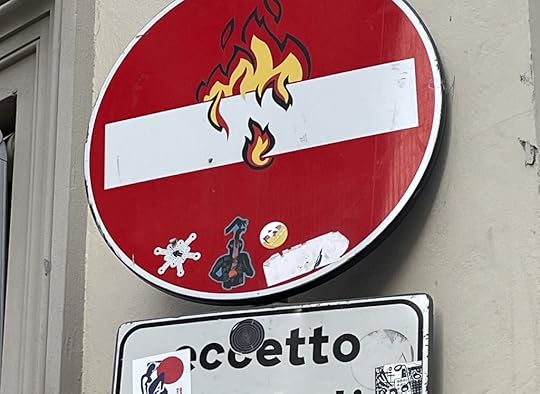
Holiday snaps have to show various meals consumed, so here are some of our favourites: we returned to some of the restaurants more than once. We avoided obvious tourist traps where the menu consists of photographs of the food and tried only to eat in places where the specials listed in the window were all in Italian. Every meal we had was superb. And, of course, Tuscan wine is famously good. We particularly liked the Villa Antinori 2022 though also drank a fair amount of Chianti Classico.


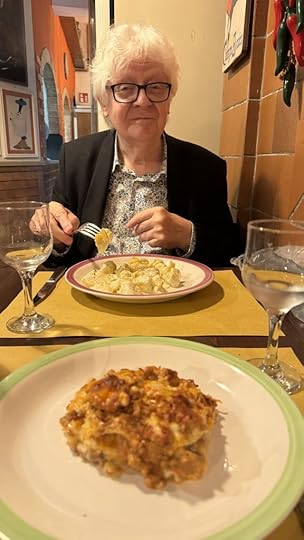
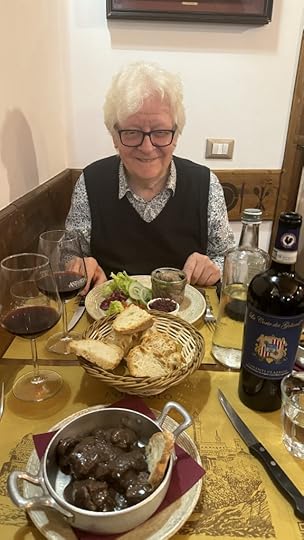



There is so much to see in Firenze that you must be selective. We concentrated on Michelangelo and saw most of sculptures that are in the city’s museums and churches as well as the Doni Tondo in the Uffizi. It’s worth pointing out that the Florence Pass is more trouble than it is worth. No-one seemed to know anything about it and at the Uffizi we were eventually given a phone number to call to get the supposed priority booking. The organisation at the Accademia and the Uffizi was appalling, though a friendly young woman at the desk devoted the best part of twenty minutes trying to help us (and succeeded, eventually). So off we went, hoping for a case of the Stendhal Syndrome.


We walked to the Palazzo Pitti, and, as the rain had cleared, we went first to wander around the Boboli Gardens. There I was absurdly proud of myself for recognising part of Ramesses II’s cartouche on the obelisk there (Aswan c1260 BC). (Theo and I had been in Egypt two months earlier). There were some nice things in the museum including a Caravaggio that I missed but Camila photographed, and works by Raphael, Titian and Botticelli. Camila did our usual ‘Self portraits with ceiling’ and I managed to get a picture of her contemplating her future, as a row of doors opened before her into infinity.





April 9, 2025
April 2025
Well, as we can see, the American experiment didn’t work. As Oscar Wilde memorably said, ‘America is the only country that went from barbarism to decadence without civilisation in between.’ Most of its citizens can barely find their own country on a map and the country itself is run by a bunch of imbeciles. It is clearly time for Europe to take back the territory and start again. First to return all ancestral land to the indigenous people, of course, then restore New France (Louisiana, Mississippi, Arkansas, et al) to French administration. Quebec would probably be prepared to take on the task of building civilisation and introducing European culture there. The 13 original English colonies – from New Hampshire down to Georgia – should return to the crown, and in this English-speaking Canada would probably be prepared to take on the task of introducing European values and culture. The Spanish colonised Florida, California, Texas, New Mexico. Arizona and parts of other states. It’s unlikely that Spain would want the enormous task of administering such a large area so no doubt Mexico could be brought in to do so for them as well as introducing edible food. An exception might be made for the Duke of Westminster whom I understand would quite like Florida back, but that could be negotiated. As for the mid-west; perhaps build a wall around it, Americans are seem to like walls, though it would probably be a good idea to remove the better things from the Chicago Art Institute, the MCA, the Cleveland Art Museum and a few others to New York first for safe keeping. It is a big task, and there might be some objections, but for the health and safety of the planet it has to be done.

March 30, 2025
March 2025
Back from Egypt and the social round takes over. Theo and Minako took me to Mon Plaisir, one of my favourite restaurants, for my birthday. There was a private view of the Leigh Bowery show at Tate Modern. Hannah Watson, who has just closed her T.J. Boulting gallery to concentrate on Trolly Books publishing and I went with her. I wrote an essay in the catalogue when she put on a Bowery show at the Fitzroy Chapel. Leigh’s work is unique, wonderful and startling even now, thirty years later. Well worth seeing. I’m afraid some of the costumes the guests wore seemed a little sad. Hannah appeared to know half the people there and it was fun watching her take pictures. Clearly closing the gallery has been a weight off her back. Later in the month a very pleasant lunch with Tom Neurath at the Palestinian Restaurant in Golborne Road together with Terry Wilson, Luzius Martin and Richard Adams, very much the old gang.


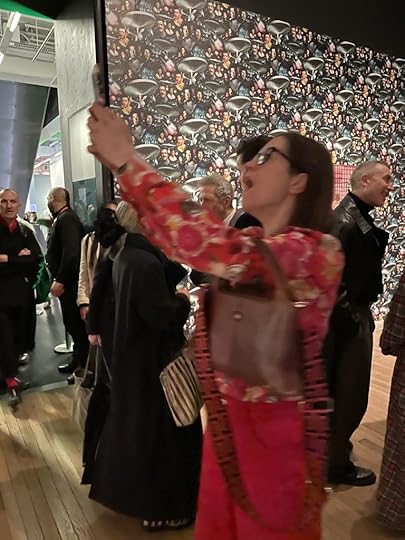

The October Gallery were having a William Burroughs show, which turned into a William Burroughs festival with talks and film-shows. Burroughs expert Oliver Harris did an in-conversation with Kathelin Gray, one of the directors of the gallery, who knew Burroughs old. I lent a couple of paintings for the show. The private view was on March 5, and I was able to chat to John Dunbar, who I hadn’t seen in some time, and and his son Nicholas, who I hadn’t seen in decades. Nicholas’s mother was Marianne Faithfull whom I first met back in 1965 with John when we were first starting Indica Books and Gallery, who was then married to her. I even went with John to her hospital bed at the London Clinic where she was confined with Nicholas.
About a year ago there was a short festival at the Horse Hospital called Allen Ginsberg in London. As Marianne knew Allen very well, I asked if she would read Howl. She and Allen and I had many fun evenings together over the years both here and in New York. She was initially enthusiastic, but as I expected, decided against it as she was already in a wheelchair and there were no proper facilities there for her. We have lost a remarkable woman. Here she is with her mum who used to steal all our cigarettes and one that my old friend Hoppy took in 1965.

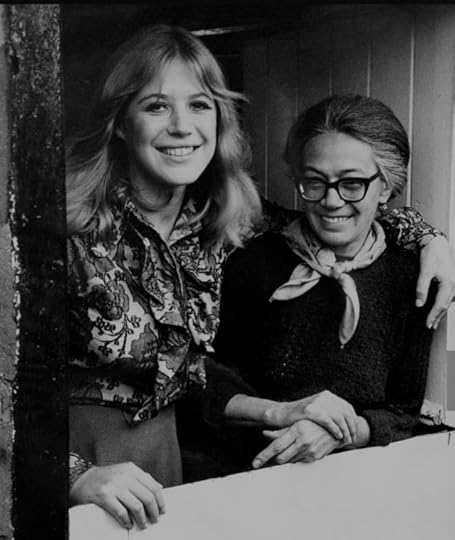
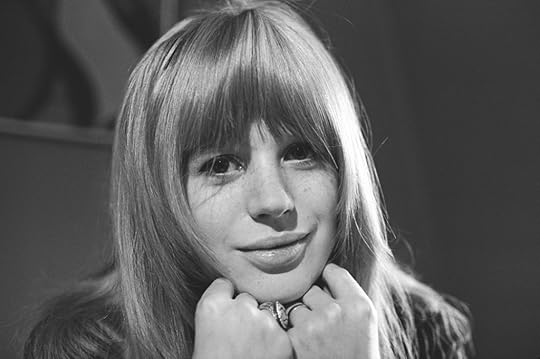
Soho still has its attractions, and a lunch at the Academy Club turned into an afternoon of drinking with my new friend Lucy who makes TV films. She recently published two books by a homeless alcoholic called Nigel Staley: Sleeping Around (2023) and Hostel (2024). I initially thought that he must have dictated them to here but no, they are entirely his. He is lucid, inciteful with a good eye for the minute particulars. Then he loses it and goes on a binge and loses everything which, when he recovers, he describes in detail. It is a bit uncomfortable to read because we all know these people; it seems so familiar, the unrolled sleeping bag and pathetic pile of possessions in a doorway or the lone drunk, standing in the road, shouting obscenities at the traffic. I hope he gets a proper publisher one day as it is really good writing and, as they say, ‘painfully authentic.’
Suzy Treister had a nice opening at Annely Juda followed by an Indian banquet at Roti Chai that was fun. There’s an interview with her in the spring edition of Tate Etc. magazine. Andrew Wilson and I did an in-conversation as part of the William Burroughs festival at the October Gallery that sold-out – but that was because the tickets were free. However, there were people standing and I didn’t see anyone leave. My old friend the art critic and writer Raymond Foye was over from New York for a brief visit, and we managed to have a drink afterwards and he came to dinner. He has helped so many writers and artists over the years, particularly the more difficult ones like Gregory Corso, Herbert Huncke, John Wieners and Harry Smith. He brought with him a pile of Hanuman Press books, which he published, none of which I had, so that was a brilliant present. I hadn’t seen him in over a decade so there was a lot of gossip to catch up on. Here’s Lucy, Suzy, Raymond and me.



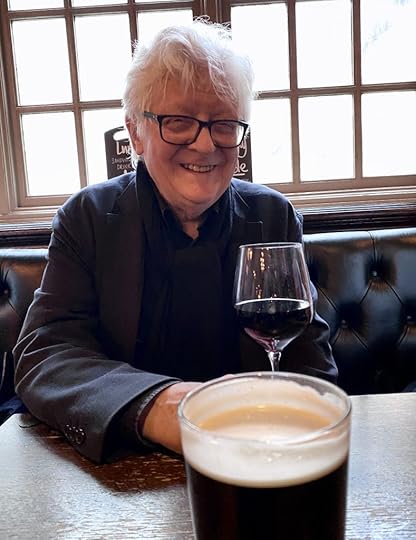
A quick follow-up to Theo and my trip to Egypt. In the British Museum there is a fragment from the beard of the Sphinx. It is not from the original 4th dynasty ruler Khafra but probably comes from the repaired beard made a 1000 years later by Thutmose IV (1400-1390 BC). Other similar fragments are in the Egyptian Museum in Cairo. I had to check it out. While we were in Egypt, Mina was in Japan and brought back a beer with a portrait of Theo on it.


March 23, 2025
2025 02 Feb Luxor
Our final tomb was KV09: Rameses V and Rameses VI. Here we find a huge amount of art, not all of it by competent artists though they are all very keen on depicting bound and decapitated enemies. The tomb is of five long corridors connected by nine gates and a couple of chambers en route. The corridors are really steps, descending into the rock but as this is where all the art is, one takes one’s time and appreciates the fact that it is not that steep.


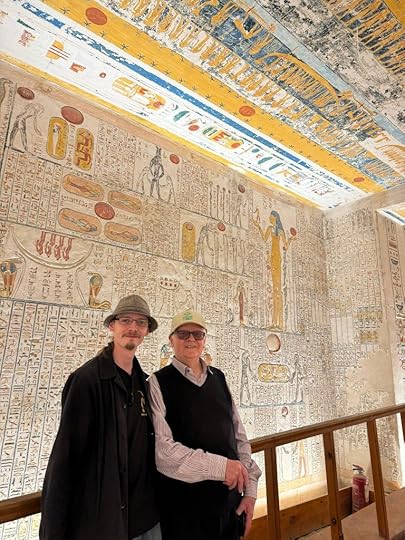

The ceiling paintings in the burial chamber of the Book of the Day and the Book of the Night were really extraordinary but, as usual, I wished we had Tom Hardwick or another knowledgeable Egyptologist with us to explain it all. Their pantheon was so complicated and kept changing.



Then it was back on the jitney to the car and an English pub – so called – in Luxor. The only great thing about The Kings Head Pub is that they use the face of Akhenaten as the King in their inn sign, but Theo was amused to see what they regarded as an English pub. They try and refill your glass when it is still half full so it becomes impossible to tell how many glasses you have had. The food, like most food we had, was terrible, but I’m glad we went.
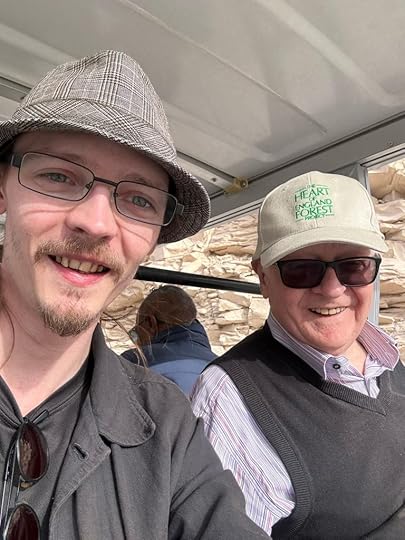


February 7th was our last full day in Luxor. We went first to Medinet Habu, the mortuary temple of Rameses III. This is one of the least visited sites in Luxor, perhaps because it is easier for tour organisers to concentrate on the Valley of the Kings where everything is in one place. There were few people there. We ignored the Ptolemaic entrance and headed straight to the First Pylon which is over 1000 years older. The Habu temple is second only to Karnak in size and has huge, deeply cut reliefs of Rameses ‘s various triumphs in battle. They estimated the number of enemy dead by counting the number of hands and genitals sliced from their bodies, as shown in the First Pylon relief. Gruesome stuff. Adjacent to the pylon are the remains of the Royal Harem. Unfortunately, it was closed, but had we known, you can see where the Pharaoh ‘frolicked’ with his harem, as the Eye Witness guide puts it, as the outer wall of the second floor apartments is missing. Bring binoculars. Here Theo examines the relief of Rameses’ staff counting piles of hands, and a view of the dancing girls in the harem, which is where, of course, R III met his death by a large sword. Maybe from the very wife, seen here being tickled under her chin (I didn’t take this, I found that on the net).



Then came the First Court, where the reliefs of real battles are, which is enclosed by a spectacular set of Osiride columns showing Rameses III. I think it must be the fact that these come from the very beginning of Western Civilisation, they were there long before the Greeks, quite apart from the Romans and all the squabbling empires since, that makes them so awesome. And if course the workmanship which is often very delicate and obviously the work of a true artist. As Maria Golia lives right next door, we went for a late coffee with her before heading back across the river. Here’s Theo outside her village.

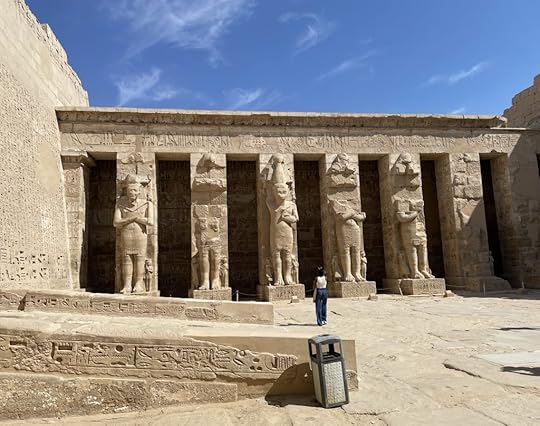
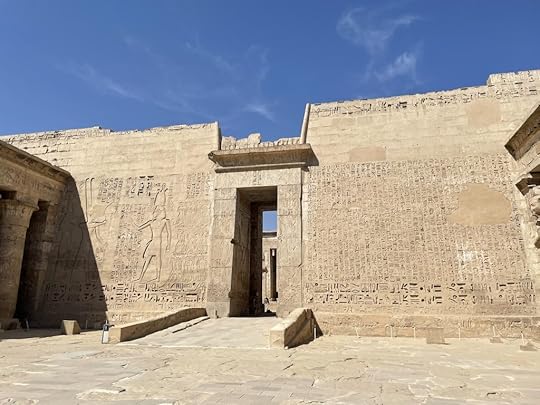
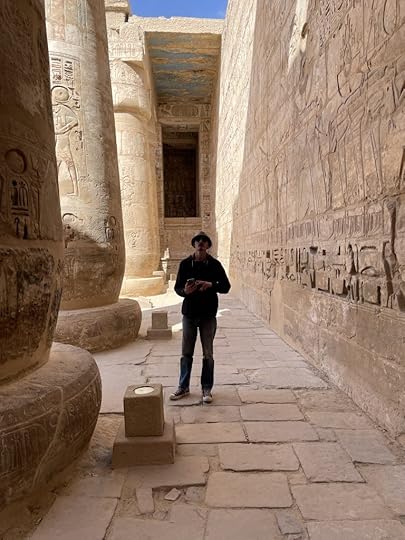


Next day it was goodbye to the Nefertiti. I was getting quite fond of living there with all the cab drivers jostling to hustle you just outside the entrance to the alley, except for the food that is.
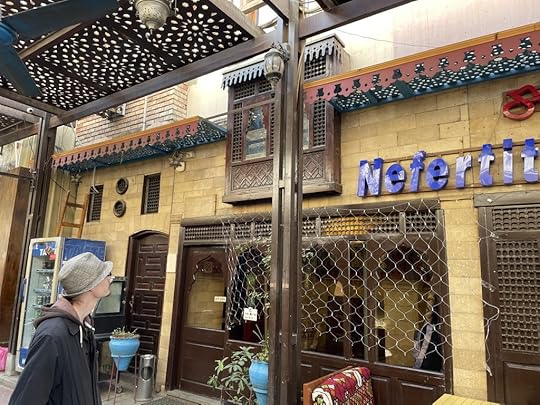

We flew to Cairo and returned to our old rooms at the Carlton. We just had time to have lunch with Mira Shihadeh whom we met at Maria’s place next to the Habu temple. She suggested that we meet at Café Riche. Just two blocks from Tahrir Square, on Talaat Harb Street, this has been the centre for dissent and literature, intellectuals and revolutionaries for over a century. It was founded in 1908 and features all the usual faded photographs of celebrities and souvenir paintings and artifacts of memorable dinners or celebrations that make this type of café so great. Most towns have one: there are lots in Paris of course: La Coupole, le Select, le Deux Magots, Café de Flore, la Closerie des Lilas, Le Dome and le Procope; Berlin has the Paris Bar; Barcelona has Els Quatre Gats; Madrid the Café Comercial; I suppose the Caffè Florian in Venice would have to count though it’s hardly welcoming to writers these days; the Café Central in Vienna; maybe even the revived Cabaret Voltaire in Zurich. So Café Riche is one of these. Its two most famous patrons were the future president Abdel Nasser, who plotted the overthrow of King Farouk there and Nobel prizewinning novelist Naguib Mahfouz who used it as his personal club, Umm Kulthum was once the resident singer. So a perfect place to meet. It also serves alcohol. In fact, the house wine was the best I had in Egypt. The food: ho-hum, but cheap.
It was great to see Mira again. She filled in details of her life: MA in psychology then 20 years as a yoga instructor, but now a figurative painter, inspired very much by graffiti-street art and the MeToo movement. What was fascinating was to hear of the fear and stress, excitement and exhilaration of the 2011 revolution in Egypt when the Café Riche became a shelter for demonstrators and the injured. Naturally we also talked of the Israeli attempts to depopulate Palestine by killing off its population; the hours of interrogation before she is allowed into her own country to visit relatives. It all brings home the day-to-day problems faced by Palestinians in the face of the occupying Israelis. One day they will get their land back, but I doubt I’ll be around to see it. Here we are at Café Riche, the next day back in Blighty.

March 16, 2025
11 March 2025 Luxor
As if Queen Hatshepsut wasn’t enough, we now headed for the Valley of the Kings. Virtually all of the kings of the New Kingdom chose to be buried here, so there are 500 years of royal burials -roughly 1500 – 1000 BC. Pretty much all have been found including that of Thutmose II – found since we were there, washed out by floods shortly after he was buried, but a royal tomb none the less. His new burial place seems on the verge of being discovered.
Our first tomb was KV8, King Meremptah. The tombs are numbered in order of discovery and Meremptah has been open since antiquity. It was badly damaged by flooding in antiquity, but large sections of painting remain: the Book of Gates and the Amduat that appear in almost all tombs are there. We got to recognise them eventually.



I quickly realised that I was not going to see as many tombs as I’d possibly hoped. They each consist of a series of long corridors connected by long stretches of steps that lead down to the burial chamber deep in the rock. En route there will be several rooms and a well shaft. That could involve way over a hundred steps which at my age is asking for trouble. The walls and ceilings are usually painted so it is all extremely interesting, just exhausting. Theo saw more than I.
We next visited KV8, the tomb of Rameses IX. It’s another one open since antiquity and was only about half finished at the time of the King’s death. Most of the wall paintings are crudely executed. It was the first time I’d seen any indication of the erotic life of ancient Egypt. Though the Christian censors had been at work (of course), there were a few figures they missed. We only know ancient Egypt from its tombs and temples, neither of which were ever likely to give much indication as to the actual life of Egyptians, rich or poor. All the wall paintings of their houses are long gone. There is, however, one miraculous discovery giving a glimpse of their erotic lives and that is the Turin Erotic Papyrus (Museo Egizo, Papyrus 55001) from this period, 1150 BC, that is 2.6 metres (8.5 feet) long and depicts various sex positions. It’s a bit like stumbling upon the erotic frescos in Pompei. One gets the sense that that they had a much healthier attitude to sex than we do.


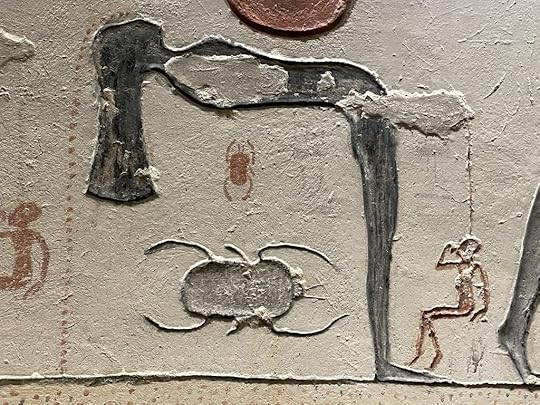
Theo went to K16 by himself; I saw how many steps there were. It is the tomb of Rameses I and looked very interesting with some large scale paintings. Like so many of the tombs it was unfinished at the king’s death and has suffered from flood damage.



The best tomb we saw, the one you mustn’t miss, you have to pay extra for: tomb KV17, Sety I (died 1290 BC). It is regarded as the pinnacle of New Kingdon tomb painting. The paintings are superb, the colours fresh, and the images as surreal as only Egyptian tombs can be. Here in the circumpolar astrological star map on the ceiling of the burial chamber we have the Goddess Taweret, protector during childbirth: a pregnant hippopotamus standing upright with the paws of a lion holding an ankh. The crocodile on her back is her husband Sobek, father of Horus, who is sometimes shown as her back. In Egyptian astrology Taweret represents the stars of the Hippopotamus Constellation in the northern sky though as yet no-one is sure exactly which ones.
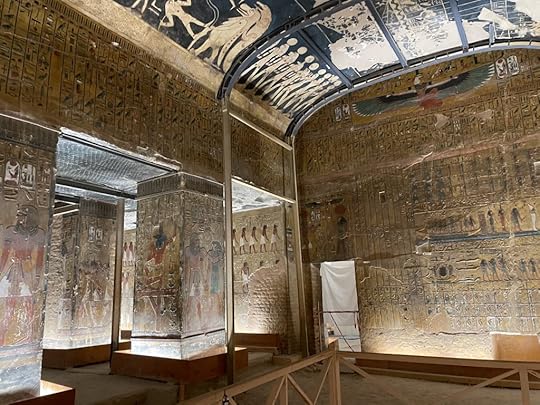


There are lots of pictures of Sety being embraced by the Gods: Isis, Neith and Hathor – he can’t keep his hands off them. There is also a great painting of Hathar. I was most intrigued to see that the Paul McCartney painting I have above my fireplace is taken from this image of Hathor. For some reason I thought it must be from something galloping about on his ranch in Arizona. I recognised it immediately. (Photo by Suzy Treister). This tomb is like looking at two or three retrospective art exhibitions. I don’t normally look carefully at more than about 60 pictures in a show because you burn out, you can’t appreciate more than that, whereas here it is image overload. I staggered out, in as much as it is possible to stagger up a steep set of steps.



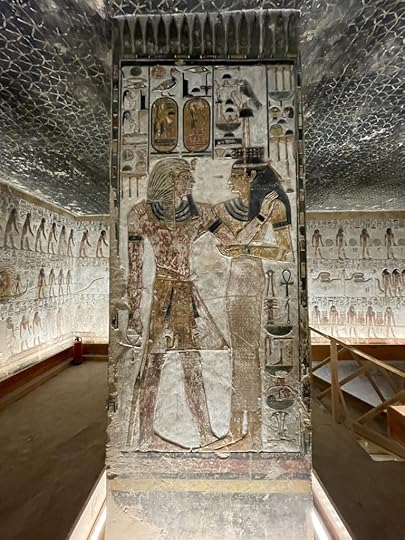


To finish with Sety I. A large number of rooms have the preliminary drawings for the wall paintings in place, but they were never completed because he died before they finished their work and the tomb was sealed. These drawings are often of the highest quality, therefore it is disturbing to see how poorly they are treated by the curators of the tomb. It’s all very well for Zahi Hawass to demand the Rosetta Stone back, but it was being used as the roof of a chicken coop when the French archaeological survey discovered it and is now under maximum protection in the British Museum. Whereas now, in contrast we can see these amazing, priceless preliminary drawings remaining totally unprotected in Sety’s tomb. There is a doorway with four steps down into the next room. Naturally people steady themselves against the wall on either side to descend. There is no protective glass screen, there is no handrail. The 3500 old drawings are stained black from the tourists’ hands as they steady themselves against the drawings to get to the next room. How long this tomb will last is hard to tell, but unless proper protection against damage from backpacks and the like is provided soon, the cash cow of the Egyptian economy will ultimately disappear, and the world will be a poorer place because of it. This tomb is one of the world’s greatest treasures, fix it up!

Fortunately there is a cafe in the very centre of the Valley of the Kings where one can sit and contemplate what one has seen and enjoy a cup of coffee. Even there, staring out at the barren cliff face, you are faced with the old ethical questions. Are we no different from the tomb robbers of old? We open the tombs, steal their treasures and these days place them in museums rather than private collections but what is so different? They wanted to be left there for eternity. To sit in the café surrounded by tourists who know virtually nothing about the lineage of the New Kingdom, who care nothing for their Gods and Goddesses, who just take a bunch of selfies that they will probably never even look at, I certainly felt out of place, and wondered, ‘where is Sekmet when we need her?’ No, I’d reserve her for taking out Trump and his criminal gang rather than the sheep-like tourists, such as myself, trudging round the sacred ground of the first Western civilisation, despoiling everything, eyes open in wonder.


Barry Miles's Blog
- Barry Miles's profile
- 150 followers



